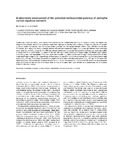A laboratory assessment of the potential molluscicidal potency of Jatropha curcas aqueous extracts
Date
2008-05-05Author
Chimbari, M.J.
Shiff, C.J.
Publisher
Taylor & FrancisType
Published ArticleMetadata
Show full item recordAbstract
Preliminary laboratory studies were conducted to determine the molluscicidal potency of Jatropha curcas, the physic nut. Biomphalaria glabrata and Bulinus globosus snails were exposed to varying concentrations of aqueous extracts of crushed J. curcas seeds from unripe, ripe and overripe fruits collected from two geographically different sites, (Bindura and Kariba, Zimbabwe). Snail mortalities were compared between different developmental stages of J. curcas and between seed collection areas, and LC50 and LC90 values for the different extracts tested were computed. Biomphalaria glabrata was most susceptible to unripe fruit seed extract (with LC50 values of 282 and 389 mg l-1 being recorded for Kariba-origin and Bindura-origin plants, respectively) and least susceptible to ripe fruit seed extracts (with LC50 values of 605 and 708 mg l-1 being recorded for Kariba-origin and Bindura-origin plants, respectively). Bulinus globosus was most susceptible to overripe fruit seed extract (Kariba-origin plants: LC50, 389 mg l-1) and least susceptible to unripe fruit seed extract (Kariba-origin plants: LC50, 687 mg l-1). The area from which fruits were collected did not influence the potency of J. curcas. The potency of J. curcas depends on both the developmental stage of the fruit and the species of the target snail. In view of its many other uses, besides as a molluscicide, we recommend further studies on J. curcas.
Collections
- Research articles (ORI) [270]

